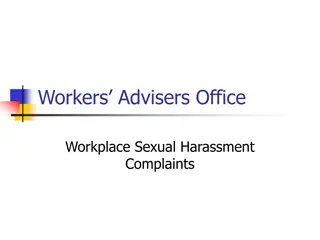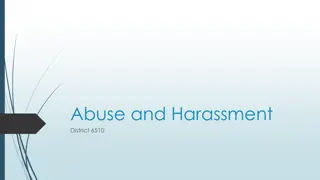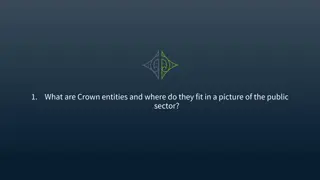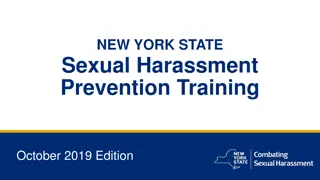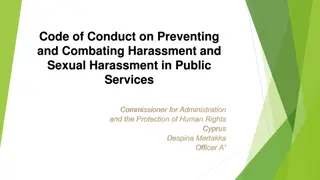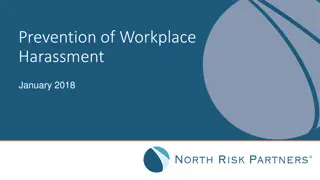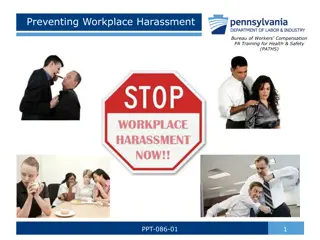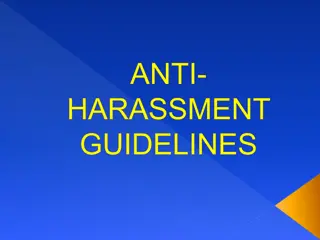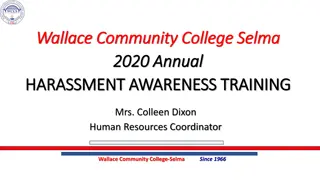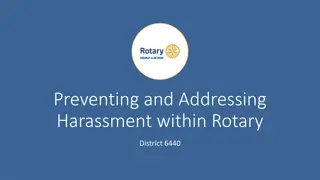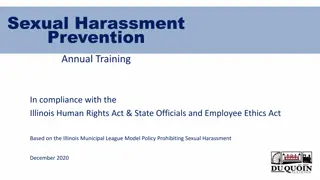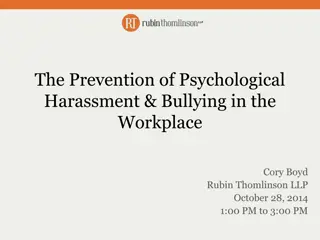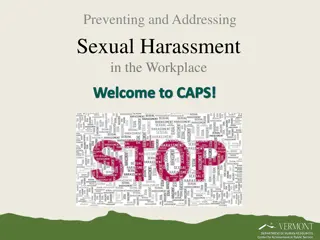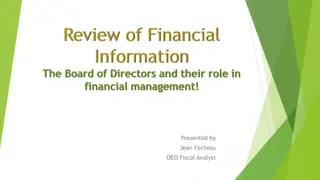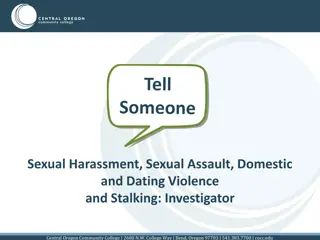Understanding and Addressing Harassment in Community Boards
This session covers the identification of harassment types, techniques for combating harassment, legal actions to address it, and board liability. It emphasizes creating a harassment-free community, defining harassment, and the board's role in tackling this issue. The course of conduct causing emotional distress and harm with no legitimate purpose is discussed. The presentation emphasizes the importance of recognizing, addressing, and preventing harassment.
Uploaded on Aug 11, 2024 | 0 Views
Download Presentation

Please find below an Image/Link to download the presentation.
The content on the website is provided AS IS for your information and personal use only. It may not be sold, licensed, or shared on other websites without obtaining consent from the author. Download presentation by click this link. If you encounter any issues during the download, it is possible that the publisher has removed the file from their server.
E N D
Presentation Transcript
Stop Misbehavin Dealing with Harassment
Northern California Panel Sandra Gottlieb, Esq. - SwedelsonGottlieb Christina McCandless, CCAM - Principle AMC - ACMC Lisa Tashjian, Esq. - Beaumont Tashjian
Outcomes At the conclusion of this session, attendees will be able to educate Board Members regarding: The identification of types of harassment Techniques for fighting harassment, without fighting Legal actions that can be taken to address harassment Board liability when harassment is not dealt with
What is the Boards role in creating a community that does not tolerate harassment of any kind?
Boards Role Identify the problem. Identify the medium. Identify the impact of problem.
Scope of Board Authority and Duties Enforcement of governing documents Fiduciary
How is harassment defined? Unlawful violence, a credible threat of violence, or a knowing and willful course of conduct directed at a specific person that seriously alarms, annoys, or harasses the person, and that serves no legitimate purpose.
How is harassment defined? (Cont.) The course of conduct must be that which would cause a reasonable person to suffer substantial emotional distress, and must actually cause substantial emotional distress. (California Code of Civil Procedure 527.6(b)(3).)
How is harassment defined? (Cont.) Harassment: a serious act or course of conduct directed at a specific person that: o Causes a substantial emotional distress in such person; and o Serves no legitimate purpose (15 USC 1514)
Quid pro quo Harassment A demand to engage in conduct as a condition related to the provision of services or facilities in connection with their dwelling
Hostile Environment Harassment Severe, unwelcome conduct that interferes with another s enjoyment of their home or the enjoyment of the facilities in connection with their home
How do you identify harassment?
The State and many municipalities have additional protected classes.
An association or management company can be held liable for a resident s harassment when the harassment is based on:
o Race o Color o Religion o Sex o National Origin o Disability o Familial Status
The association and/or its management company may be liable for failing to take prompt action to correct and end discrimination by a third party, where the association or management knew or should have known of the discriminatory conduct and had the power to correct it.
What is meant by Due Diligence?
How do I educate my Board in understanding their role? Board Orientation Directors Fiduciary Responsibility Resolution Signed Code of Conduct for Directors & Committee Members Continuous Education of Policies & Procedures
What are some specific examples of Board policies that address homeowner behavior?
Vendor Harassment Types of harassment Forms of harassment Steps to follow when dealing with vendor harassment
When is it time to involve an attorney?
Legal Options Cease and Desist Letter Stop Workplace Violence Restraining Order Civil Harassment Restraining Order Civil Action
Communicating Harassment Policies Effectively How? What? Where? Frequency?
Important Considerations for Addressing Policy Violations
Sound Familiar? Scenario 1 Face to Face Harassment A manager is conducting a board meeting at the association s designated area, when a homeowner begins to interrupt the manager with offensive language & frustration towards the developer.
Sound Familiar? (Cont.) Scenario 2 Phone Call Harassment A homeowner contacts the management company demanding to speak with the manager of the association. The management team advises the homeowner that manager is not available & offsite conducing site reviews. The homeowner becomes immediately upset & begins to express her sense of dissatisfaction with the managers quality of service & competence level of the company.
Sound Familiar? (Cont.) Scenario 3 Social Media Harassment Abusive or harassing communications Manager, Management Company employee, or Board member receiving abusive email communications with offensive language, name calling, or threats.
Key Concepts Reasoning with any angry person is not possible. De-escalation techniques are inherently abnormal.
De-Escalation Techniques for Managers Look for signs of agitation Self-Control Active listening
Ending De-Escalation When the individual has calmed down, you can then begin to address the situation in the same patient & professional manner.
Ending De-Escalation (Cont.) In the case where the individual does not respond to the de-escalation techniques, quickly and respectfully end the interaction by concluding the meeting without putting yourself or others in a hostile environment.
Hostile Work Environment An unwelcomed or offensive behavior in the workplace, which causes one or more employees to feel uncomfortable, scared, intimidated in their place of employment.
Northern California Panel Sandra Gottlieb, Esq. - SwedelsonGottlieb, slg@sghoalaw.com, (415)762-1889 x 202 Christina McCandless, CCAM - Principle AMC, christina@principleamc.com, (888) 747-5548 x700 Lisa Tashjian, Beaumont Tashjian, LTashjian@HOAattorneys.com, (866)788-9998



